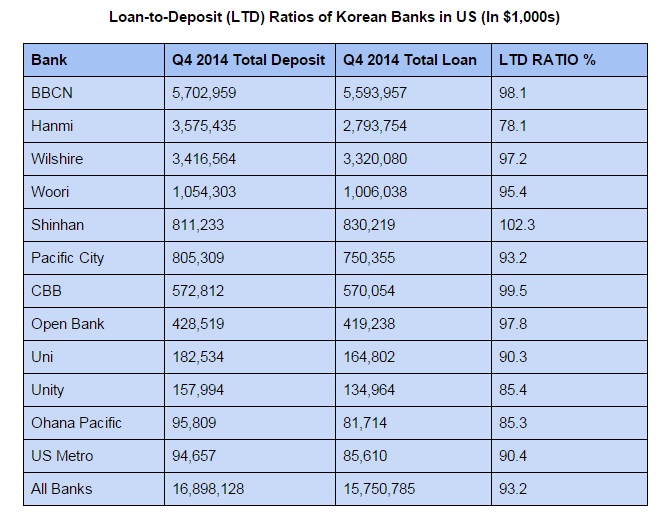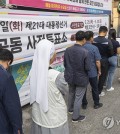- California Assembly OKs highest minimum wage in nation
- S. Korea unveils first graphic cigarette warnings
- US joins with South Korea, Japan in bid to deter North Korea
- LPGA golfer Chun In-gee finally back in action
- S. Korea won’t be top seed in final World Cup qualification round
- US men’s soccer misses 2nd straight Olympics
- US back on track in qualifying with 4-0 win over Guatemala
- High-intensity workout injuries spawn cottage industry
- CDC expands range of Zika mosquitoes into parts of Northeast
- Who knew? ‘The Walking Dead’ is helping families connect
Korean banks in US running out of funds to loan
The loan-to-deposit ratio closes in on 95% mark
By John Cho, Brian Han
The loan-to-deposit (LTD) ratio remained high among the listed Korean banks located in the U.S. at the end of last year. Korean banks in Hawaii, California and Washington are reaching the upper limit of how much they can loan.
They have been operating on a surplus since 2011 and are now hitting critical points.
The most recent data from the 2014′s fourth quarter reveals an average LTD ratio of 93.2 percent for the top 12 Korean banks.
Shinhan Bank’s LTD ratio is the highest of the listed banks at 102.3 percent signifying that it has exceeded the funds available from deposits for loans.
The next highest LTD ratio is held by Commonwealth Business Bank (CBB) at 99.5 percent, then BBCN at 98.1 percent, Open Bank at 97.8 percent, Wilshire Bank at 97.2 percent, Woori America at 95.4 percent, Pacific City Bank 93.2 percent, U.S. Metro at 90.4 percent and Uni Bank at 90.3 percent.
The lowest LTD ratio belongs to Hanmi Bank at 78.1 percent, mainly due to its recent acquisition of United Central Bank in Texas.
When banks are operating above 90 percent it means that they are aggressively loaning in an attempt to raise profit levels.
If they are below 80 percent, it usually means that they are handling loans in a more conservative fashion.
One of the main reasons for the increase is due to rising real estate prices, putting banks in a position to loan more of their available funds.
The 12 banks’ deposit total actually rose from $14.4 billion in the fourth quarter of 2013 to $16.8 billion in the fourth quarter of 2014. But the amount of loans also rose from $13.6 billion to $15.7 billion in those same quarters.
According to Korean bank officials, it’s simply the case of supply (deposits) being unable to keep up with demand, as they try to stay within the guidelines of the Federal Deposit Insurance Corporation (FDIC).


















Pingback: City Bank In Korea | interest - probanker
Pingback: Korean Banks In America | diamond - bank loans